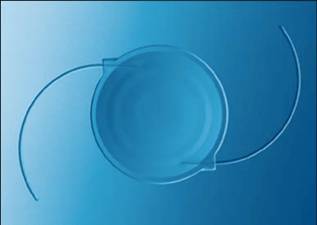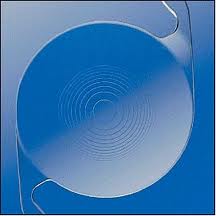Presbyopia Correction
Presbya
A new method for the management of presbyopia that has been applied in LVO for the past 3 years with excellent results so far is the intracorneal Presbya inlay. During this minimally invasive procedure, that lasts only a few minutes, a small lens is placed into the cornea in order to correct presbyopia. The tunnel creation for the insertion is performed by a 5th generation iFS Advanced Femtosecond Laser with absolute precision. The procedure involves only one eye, is painless and local drops are used.
New method for near vision improvement (without glasses) in patients with presbyopia and after cataract surgery
Cataract is the commonest cause of reversible loss of useful vision worldwide. Treatment of cataract consists of surgical removal of opacified crystalline lens. Currently, the procedure of choice for cataract surgery is extracapsular cataract extraction with phacoemulsification followed by intraocular lens implantation. 1-3
The major drawback of crystalline lens removal is the loss of its accommodative ability. Traditionally used monofocal intraocular lenses provide exquisite visual acuity at a single, fixed focal length. Thus, correcting the distance vision, patient will require spectacles for near. Increased patients’ demands for both distance and near vision and spectacle independence have forced ophthalmologists to search for new solutions.
Even though there are procedures and techniques with undeniable value, contemporary ophthalmology has not completely answered the postcataract surgery presbyopic dilemma. There is still a need for a safe, effective and reversible surgical technique with an easy learning curve for patients.
This necessity led to the development of refractive intracorneal lens (inlay) (Presbia Microlens™) placed inside a pocket in the corneal stroma. The Microlens is refractive lens that have a central zone free of refractive power and a peripheral zone with a standard positive refractive power. The inlays are inserted inside a pocket in the corneal stroma of the non dominant eye, offering two different focal points, one for the far vision and a different for the near vision respectively. The pocket of the cornea is created using a femtosecond laser.
The Presbia Microlens™ is a transparent, hydrophilic disc with 3 mm diameter and approximately 15 μm edge thickness. The central 1.6 mm diameter of the disc is plano and the peripheral zone has an add power. The base power available range from +1.50 D to +3.50 D in 0.25 D increments.
The lens is implanted inside a pocket of the corneal stroma in the center of the visual axes of the non dominant eye.
The Presbia inlay has a bifocal optical system which acts as a modified monovision (smart monovision). During far vision the rays pass through the central zone of the inlay without refractive effect and will be sharply focused on the retina, whereas the rays which pass through the refractive peripheral zone will be not of focus in front of the retina. During near vision, the rays which pass through the central zone will be out of focus behind the retina and the rays which pass through the lens peripheral refractive zone will be focused on the retina. As a result, only the peripheral zone of the lens provides the near vision correction, and affects far vision, whereas the central zone of the lens and the peripheral unaltered part of the cornea do not affect the far vision.
In conclusion, this method is easy, simple, painless and is intended for people who undergo cataract surgery but do not wish to wear near vision glasses afterwards and for people older than 40 years, with presbyopia who want to improve their near vision without wearing near glasses.
 |
 |
 |
Multifocal or Accommodative Intraocular Lens implantation
Multifocal or Accommodative intraocular lens implantation constitutes a very promising alternative solution for presbyopia correction because these lenses can achieve simultaneous satisfactory distant and near vision.
Multifocal intraocular lenses are a treatment option, resulting in satisfactory vision, for both distant and near, without the use of spectacles. Functioning in a way equivalent to multifocal glasses, these lenses give the possibility of focus in various distances and consequently spectacle - free satisfactory vision.
Accommodative intraocular lenses are a new generation lenses, designed to provide satisfactory vision for all distances by restoring some degree of “pheudoaccommodation”. Their function is based upon the movement of the lens in the capsular bag, following accommodative effort. This movement has almost completely answered the presbyopic dilemma by simulating the accommodative properties of the crystalline lens itself.
In general, multifocal and accommodative intraocular lenses can be considered a very promising alternative solution for patients that lead an active life and require good vision near, intermediate and far.


Multifocal laser (Pesbvis)
The multifocal laser is used in cases of 45-60 years' old patients, who have myopia, hyperopia or astigmatism except presbyopia. Their vision is corrected for long, intermediate and short distances.
Flexivue(tm) Micro-Lens
A new method for the management of presbyopia that has been applied in IVO for the past 3 years with excellent results so far is the Flexivue(tm) Micro-Lens , an intracorneal inlay by Presbia. During this minimally invasive procedure, that lasts only a few minutes, a small lens is placed into the cornea in order to correct presbyopia. The tunnel creation for the insertion is performed by a 5th generation iFS Advanced Femtosecond Laser with absolute precision. The procedure involves only one eye, local drops are used and the patient does not feel any pain during or immediately after surgery.
.jpg)





